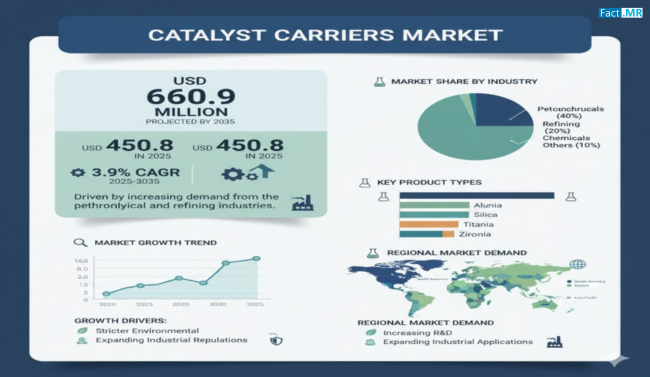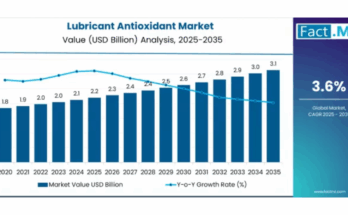The catalyst carriers market is gaining prominence as industries worldwide accelerate their transition toward cleaner, more efficient, and sustainable production systems. Acting as critical components in chemical reactions, catalyst carriers provide the necessary surface area and structural support that enhance the performance of catalysts across diverse industrial processes. The rising adoption of catalytic technologies in petrochemical, environmental, and automotive sectors is shaping the global demand landscape, making catalyst carriers indispensable for achieving both performance optimization and environmental compliance.
With the increasing focus on industrial decarbonization, companies are channeling investments toward innovative catalyst carrier materials that deliver high thermal stability, low pressure drop, and enhanced reusability. The evolving industrial landscape highlights the market’s pivotal role in driving sustainability and operational excellence across value chains.
Market Overview
Catalyst carriers form the backbone of catalytic systems by supporting the active catalytic materials responsible for facilitating chemical reactions. They are typically composed of materials such as alumina, silica, carbon, zeolites, and ceramics — each selected based on the specific reaction environment and process requirements.
The market growth is propelled by rapid advancements in chemical processing technologies and the rising emphasis on achieving higher reaction efficiencies with minimal environmental impact. As industries continue to optimize production efficiency, catalyst carriers are witnessing growing adoption for their role in enhancing catalyst life, reducing waste generation, and improving process yields.
Environmental regulations targeting emission control in refineries and automotive exhaust systems are creating sustained opportunities for catalyst carrier manufacturers. In addition, industries are increasingly exploring customized solutions that align with green chemistry principles, driving innovation in material design, porosity control, and carrier morphology.
Regional Insights
North America represents a mature and innovation-driven market for catalyst carriers, backed by extensive research and strong adoption across petrochemical and refinery applications. The region’s emphasis on cleaner fuel production and stringent emission regulations is influencing manufacturers to integrate high-performance catalyst carriers within existing industrial infrastructure.
Europe is advancing rapidly, supported by the region’s aggressive sustainability goals and regulatory frameworks that promote eco-friendly industrial operations. European manufacturers are at the forefront of developing lightweight and energy-efficient carrier materials that align with circular economy initiatives.
Asia-Pacific, on the other hand, is emerging as a fast-growing hub for catalyst carrier production and application. Expanding chemical manufacturing bases in China, India, and Southeast Asia, coupled with strong governmental focus on emission reduction and industrial modernization, are driving regional demand. The region’s diverse industrial landscape, from automotive to energy and environmental management, is fostering significant opportunities for catalyst carrier suppliers to collaborate with domestic and international enterprises.
Meanwhile, Latin America and the Middle East & Africa are showing steady progress, driven by growing investments in refinery upgrades and industrial diversification projects. The gradual expansion of process industries in these regions is expected to enhance the adoption of catalyst carriers in the coming years.
Key Trends & Forecast
- Shift Toward Sustainable Materials:
Manufacturers are increasingly focusing on developing eco-friendly and recyclable catalyst carriers to reduce environmental impact and comply with tightening sustainability standards. - Integration of Nanotechnology:
The adoption of nano-structured catalyst carriers is gaining traction for their superior surface area and improved catalytic performance, enabling higher efficiency in chemical reactions. - Digitalization and Smart Manufacturing:
Industry 4.0 technologies are being integrated into catalyst carrier production, allowing for enhanced process control, reduced energy consumption, and consistent quality output. - Expansion of Application Spectrum:
Beyond traditional applications in petrochemicals, catalyst carriers are now being utilized in emerging sectors such as renewable energy, hydrogen production, and waste-to-value chemical processing. - Collaborative R&D Efforts:
Strategic partnerships between research institutions, catalyst producers, and material science companies are accelerating the development of next-generation catalyst carriers tailored to specific reaction environments.
These trends collectively indicate a future where catalyst carriers will play a central role in enabling efficient, sustainable, and adaptive industrial ecosystems.
Applications & End-Use Outlook
Catalyst carriers find extensive applications across industries that rely on catalytic processes for production efficiency and environmental control.
In the chemical and petrochemical sectors, catalyst carriers support reactions in refining, hydrocracking, and reforming units, ensuring higher conversion rates and improved catalyst longevity.
The automotive industry utilizes catalyst carriers in emission control systems, where they serve as the foundation for catalysts that reduce harmful exhaust gases and meet stringent emission standards.
In environmental applications, catalyst carriers play a critical role in wastewater treatment, air purification, and renewable energy processes such as hydrogen generation and carbon capture.
Additionally, industrial manufacturing, pharmaceuticals, and food processing industries are adopting customized catalyst carriers to optimize reaction processes, improve product quality, and lower operational costs.
As industries continue to pursue cleaner technologies and resource efficiency, the demand for advanced catalyst carriers will remain integral to achieving both economic and environmental goals.
Conclusion
The catalyst carriers market stands at the intersection of material science innovation and industrial transformation. With the global emphasis on sustainable production and carbon neutrality, the role of catalyst carriers in optimizing catalytic processes is more critical than ever.
Manufacturers are not only focusing on performance improvements but also on aligning their innovations with the principles of environmental stewardship and circular economy. The market’s future lies in balancing technological advancement with ecological responsibility — ensuring that industrial progress goes hand in hand with environmental preservation.
Comprehensive market analyses and strategic insights into catalyst carrier innovations can empower organizations to make informed decisions, adopt efficient materials, and drive long-term sustainability across industrial operations.
Browse Full Report – https://www.factmr.com/report/1263/catalyst-carriers-market



